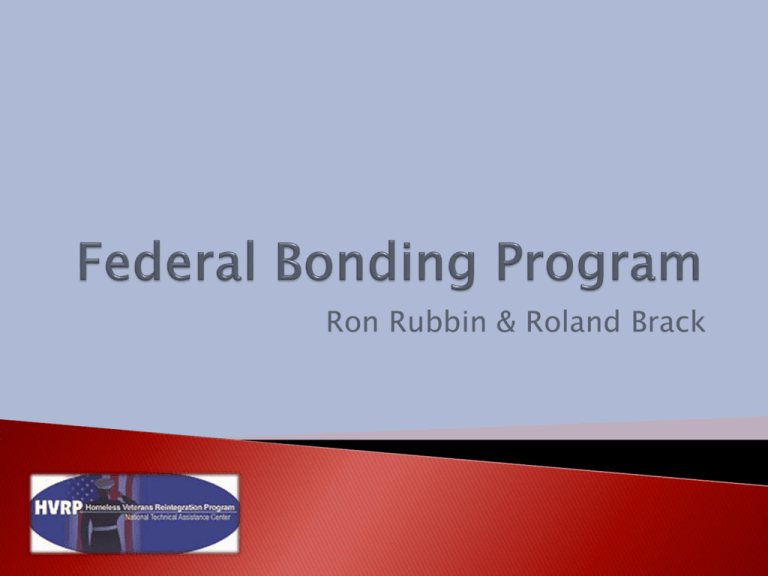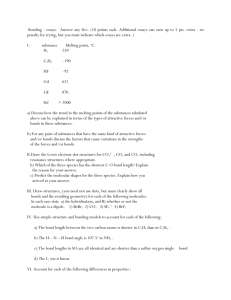Federal Bonding Program
advertisement

Ron Rubbin & Roland Brack Established in 1966 by U.S. Department of Labor (USDOL) Employer hiring incentive that guaranteed job honesty of atrisk job seekers Federal financing of Fidelity Bond insurance, issued at no charge to employers Enabled delivery of bonding services as unique job placement tool Assists ex-offenders, and other at-risk/hard-toplace job applicants (e.g., recovering substance abusers, welfare recipients, poor credits, etc.) Various State Employment Services (ES) made up national delivery system for issuing to employers Bonds purchased from Aetna Casualty and Surety Company Now owned by and operated as Travelers Casualty and Surety Company of America Job seekers who committed fraudulent or dishonest act, or who demonstrated behavior casting doubt on credibility or honesty, often rejected for employment Employers view applicants as “at-risk” and potentially untrustworthy workers Fidelity Bond insurance commercially purchased to protect against employee dishonesty usually will not cover at-risk persons They are designated by insurance companies as “NOT BONDABLE” Ex-offenders (anyone with a record of arrest, conviction or imprisonment, and anyone who has ever been on probation or parole) Total number of persons “under correctional supervision” around 7 million (1 in 32 adults) More than 600,000 inmates released each yr 67% will be recidivists (i.e., return to crime and incarceration 3 yrs of release) Failure to become employed major factor contributing to rate of recidivism Record of arrest, conviction or imprisonment is significant barrier to employment Recovering substance abusers Welfare recipients Those with poor credit record or declared bankruptcy Economically disadvantaged youth w/o work history Military with dishonorable discharge Others can be classified at-risk if barrier to work can be eliminated by making bondable Insurance purchased to indemnify employers for loss of money or property sustained through the dishonest acts of their employees (i.e., theft, forgery, larceny, and embezzlement) AKA “employee dishonesty insurance” Considered good business management practice & purchased by most employers Other types of commercially purchased insurance set premiums that vary according to degree of risk (e.g., life insurance) Fidelity Bond premiums are always low due to being based upon taking low risk Result: insurance companies usually will not cover at-risk persons under commercially purchased Fidelity Bonds Outcome: Practice has created special barrier to employment for those who encountered the criminal justice system & others Employers can determine if applicant has criminal record or has poor personal financial credit history 80% of employers now make such checks (Source: Society of Human Resources Management) Increased significantly since September 11th Not bondable under commercial employee dishonesty insurance policies (i.e., Fidelity Bonds) usually purchased by employers Led to increase in persons routinely denied jobs Bonding becomes barrier to employment Only way to become bondable by participation in FBP • • • Guarantee employer job honesty of at-risk job seekers Employers receive bonds free-of-charge as incentive to hire Reimburse employer for any loss due to employee theft of money or property with no deductible amount to become employer’s liability (i.e., 100% bond insurance coverage) Over 44,000 job placements made for atrisk job seekers who were automatically made bondable Only around 460 proved to be dishonest Bonding services as job placement tool considered to have 99% success rate NO special application form for job seeker to complete NO bond approval processing – local staff instantly issue bonds to employers NO papers for employer to submit or sign to obtain free bond incentive for job hire NO follow-up and NO termination actions required by bond issued NO deductible in bond insurance amount if employee dishonesty occurs NO age requirements for bondee (other than legal working age in State) NO other U.S. program provides Fidelity Bonding services NO Federal regulations covering bonds issued Applies to any job, any employer, any State Covers Covers any employee dishonesty committed on or away from employer’s work facility • • While assisting job seekers in securing employment is the main goal of the FBP, bonds are also issued to cover already employed workers who need bonding to prevent being laid off or to secure transfer or promotion to a different job at their company Service delivery efficiency is inherent to bonding because its cost occurs only when a job placement is generated or maintained for an individual whose background is a significant barrier to securing or retaining employment. Any full or part-time employee paid wages (with Federal taxes automatically deducted from pay) can be bonded, including persons hired by “temp. agencies” Self-employed cannot be covered by Fidelity Bonds 1997 USDOL ordered a redirection of the FBP requiring that State and local funds (including WIA and other Federal allocations) be used to purchase bonds Any public agency or private community-basedorganization or private industry group can directly acquire bonds and deliver bonding services through purchase of a bond package in accordance with the Guidelines on the Purchase and Use of Fidelity Bonds issued by The McLaughlin Company as exclusive agent for Travelers for the FBP The McLaughlin Company in Washington, D.C., under contract with the USDOL’s Employment and Training Administration (ETA) A national insurance brokerage firm serving as exclusive agent for TRAVELERS which issues Fidelity Bonds nationwide under the FBP Director: Ron Rubbin (ron4bonds@aol.com) FBP Coordinator: Roland Brack (brack4bonds@aol.com)








